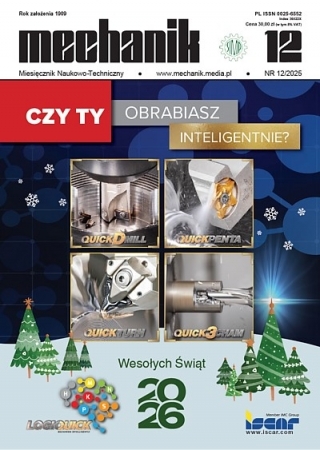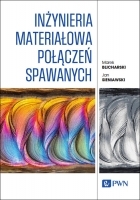Zastosowanie dwuwymiarowej transformaty falkowej do oceny chropowatości powierzchni frezowanych *
The adaptation two-dimensional wavelet transform to assessment the surface roughness produced by face milling
Mechanik nr 11/2016 - VII Kongres Metrologii „Metrologia fundamentem postępu w naukach stosowanych”
STRESZCZENIE: Przedstawiono wyniki analizy chropowatości powierzchni z wykorzystaniem dwuwymiarowej transformaty falkowej. Badaniom poddano powierzchnie powstałe w procesie frezowania czołowego elementów ze stali 40HM. Wykazano, że poszczególne postaci falki bazowej mają zdolność do wykrywania charakterystycznych obszarów w sygnałach niestacjonarnych, jednak uwidaczniają powstałe wady powierzchni z różną intensywnością.
SŁOWA KLUCZOWE: frezowanie czołowe, dwuwymiarowa analiza falkowa, chropowatość powierzchni
ABSTRACT: In this paper, authors present the research results of surface roughness analysis using the two-dimensional wavelet transform. The tests have been carried out on surface of 40HM steel produced in face milling process. The research results show the particular mother wavelet has ability to detect specific areas in non-stationary signals, however, they highlight the surface defects with different intensity.
KEYWORDS: face milling, two-dimensional wavelet analysis, surface roughness
BIBLIOGRAFIA / BIBLIOGRAPHY:
- Boryczko A. „Profile irregularities of turned surface as a result of machine tool interactions”. Metrology and Measurement System. Vol. XVIII, No. 4 (2011): pp. 691–700.
- Stępień K. „Research on a surface texture analysis by digital signal processing method”. Tehnicki Vjesnik – Technical Gazette. Vol. 21/3 (2014): pp. 485–493.
- Haar A. „Zur Theorie der orthogonalen Funktionensysteme”. Mathematische Annalen. Leipzig (1910): pp. 331–371.
- Mallat S.G. „A theory for multiresolution signal decomposition: The wavelet representation”. IEEE Transactions on Pattern Analysis and Machine Intelligence. Vol. 11, Nr. 7 (1989): pp. 674–693.
- Daubechies I. „Orthonormal bases of compactly supported wavelets”. Communications on Pure and Applied Mathematics. Vol. 41 (1988): pp. 909–996.
- Zawada-Tomkiewicz A. „Estimation of surface roughness parameter based on machined surface image”. Metrology and Measurement System. Vol. XVII, No. 3 (2010): pp. 493–504.
- Wysogląd B. „Metody diagnozowania łożysk tocznych z zastosowaniem transformacji falkowej”. Diagnostyka. Vol. 29 (2003): s. 47–52.
- Zhai L.Y., Er M.J., Li X., Gan O.P. San L. „Wavelet-based analysis of force signal for monitoring and prediction of cutting performance in high-speed milling processes”. Engineering Letters. Vol. 19 (2011): pp. 155–158.
- Krajewska J. „Wybrane problemy diagnostyki procesu obróbki materiałów trudnoskrawalnych”. Konferencja Innowacje w Zarządzaniu i Inżynierii Produkcji. T. 5 (2014): s. 749–759.
- Teti R., Jawahir L.S., Jemielniak K., Segreto T., Chen S., Kossakowska J. „Chip from monitoring through advanced processing of cutting force signals”. CIRP Annals – Manufacturing Technology. Vol. 55, No. 1 (2006): pp. 75–80.
- Jemielniak K., Urbański T., Kossakowska J., Bombiński S. „Multi-feature fusion based tool condition monitoring in rough turning of Inconel 635”. Proceedings of 4th CIRP International Conference on High Performance Cutting. Gifu, Japan. Vol. 2 (2010): pp. 285–290.
- Liao W.T., Ting C., Qu J., Blau P.J. „A wavelet-based methodology for grinding wheel condition monitoring”. Journal of Machine Tools and Manufacture. Vol. 47 (2007): pp. 580–592.
- Kwak J.S. „Application of wavelet transform technique to detect tool failure in turning operations”. International Journal of Advanced Manufacturing Technology. Vol. 28 (2006): pp. 1078–1083.
- Li X., Dong S., Yuan Z. „Discrete wavelet transform for tool breakage monitoring”. International Journal of Machine Tools and Manufacture. Vol. 39 (1999): pp. 1935–1944.
- Brol S., Grzesik W. „Zastosowanie ciągłej transformaty falkowej do oceny profili chropowatości powierzchni po obróbce zahartowanej stali AISI52100”. Archiwum Technologii Maszyn i Automatyzacji. T. 26, nr 2 (2006): s. 103–112.
- Romero-Troncoso R.J., Herrera-Ruiz G., Terol-Villalobos I., Jauregui-Correa J.C. „FPGA based on-line tool breakage detection system for CNC milling machines”. Mechatronics. Vol. 14, (2004): pp. 439–454.
- Kasashima N., Mori K., Herrera-Ruiz G. „Diagnosing cutting tool condition in milling using wavelet transform”. Advancement of Intelligent Production. (1994): pp. 339–344.
- Stępień K., Makieła W., Stoic A., Smardzic I. „Defining the criteria to select the wavelet type for the assessment of surface quality”. Tehnicki Vjesnik – Technical Gazette. Vol. 22/3 (2015): pp. 781–784.
- Zhang H., Dai S. „Image inpainting based on wavelet decomposition”. Procedia Engineering. 29 (2012): pp. 3674–3678.























